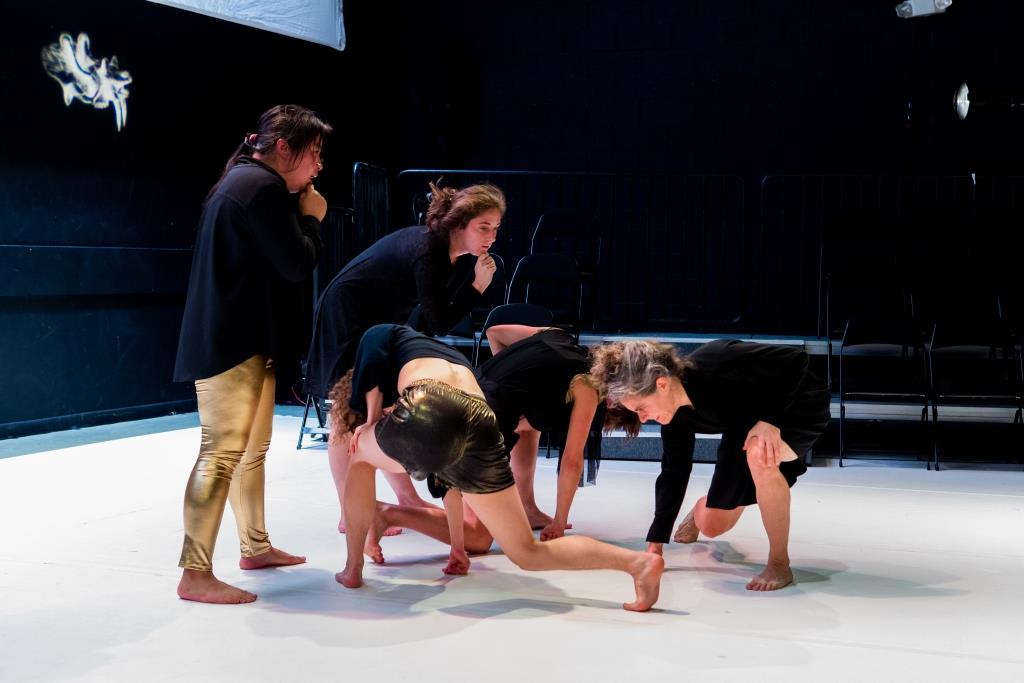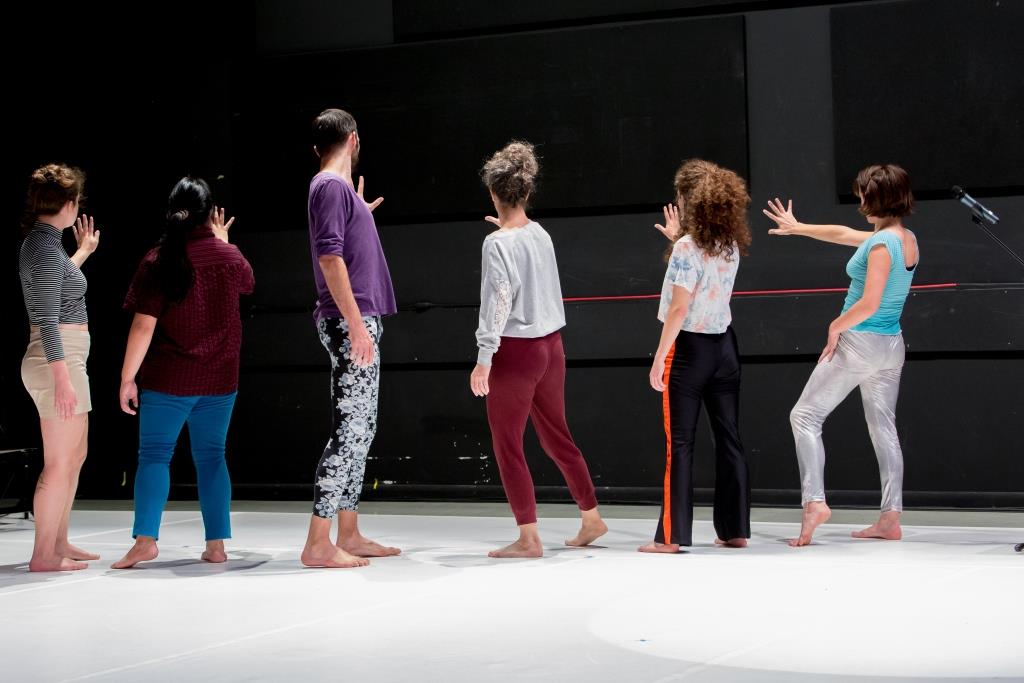Killing the Choreography
Camille LeFevre reviews the latest incarnation in Morgan Thorson's "Still Life" series, this time made for the Cowles Center in Minneapolis: an inventive choreographic amalgam, punctuated by simple, gorgeous movement

“Everyone exit but KVL,” calmly intoned the voice, as audience members took their seats on the Cowles Center’s stage. The chairs were lined up in a hexagonal shape, offering the prospect of multiple vantage points from which to view Still Life for the Cowles Center, the latest iteration in Morgan Thorson’s ongoing Still Life project. The voice also issued platitudes, recommendations, instructions; named ballet terms; and asked questions, while lighting designer Lenore Doxsee’s circle of light changed colors as it moved across the walls and the stage scrim.
KVL, for those acquainted with the Twin Cities’ “downtown” dance scene, is Kristin Van Loon; she is one of its founders, provocateurs, and most arresting performers. Later on in the piece, the six other dancers actually do exit, leaving Van Loon to execute a series of dangerously physical airborne twists—each of which ends with her in a bone-crunching heap—as they cavort in the wings, changing clothes, and calling out a cheerleading chant touting their team’s superior skills. As if.
It’s a pivotal point in the 90-minute piece. Practice and failure, endurance and rejuvenation, the discipline of solo work versus the giddy symbiosis of the collective, the professional dancer (high art) versus the quotidian group effort (cheerleading)—all are encompassed in this moment, which provides a hinge point between what’s come before and what’s coming after. And there’s a distinctive difference.

First, some backstory.
Still Life was last performed at the Weisman Art Museum in 2015 as a five-hour piece, done several days a week, throughout the summer. Billed as an “endurance-based dance work,” the piece was intended to test both dancers’ and viewers’ stamina—a characteristic clearly present in this new iteration, as well. (KVL performed in the Weisman Still Life, too). Here’s the website description of the Cowles Center version, which put dancers and viewers on the Goodale Theater stage: “Mediating death, loss, and anxiety, seven outstanding dancers are charged to kill the choreography! What happens when the dance is pulled to pieces, systematically dismantled, when the performers have nothing more to do? And how do systems of communication trigger power, action, and survival?”
The answers to those questions are still hovering, somewhere, in that liminal space of interpretation between Thorson’s artistic intentions and viewer perception. But here’s what I grasped. The first half of the performance puts the dancers, initially, in a loose line moving up and down the stage, performing a singular choreographic amalgam (one of Thorson’s trademarks) of yoga and pilates poses, everyday movements and gestures (from simple walks to miming smoking a cigarette), balletic phrases, flashes of moves from children’s games, and just simply gorgeous dancing. The kind of dancing—lush, articulate, unexpected—that’s at once fresh, captivating, and inventive.
Once again, Thorson and her dancers have generated choreographic abundance—long, finely hewn threads of intertwining, elastic, and precise movements gleaned from the diverse disciplines that created them, and which celebrate the myriad ways in which the disciplined body can move.
The dancers are outfitted with some kind of walkman or communication device (“Fondle your devices,” was another of the voice’s recommendations), festooned with red ribbons that come to resemble flowering splashes of blood or viscera spilling from the body. “The texts are vivid clues and not to be trusted,” the voice suggests, as Sxip Shirey’s cinematic soundscape conjures the notion of some fantastical underwater beast. Artifacts appear: an antique floor lamp, a wood table, a clock that reads 2017. The dancers freeze, in an off-balance pose, for interminable minutes: endurance, again.
A retching cough, kidlike goofy stomps, prancing with a hand on the chin, a flurry of arms, a Nijinsky jump, and an increasingly frenetic pace are underscored by Shirey’s grand, spooky sounds. It’s rich stuff, replete with references to any and all sorts of movement. Then KVL spins, and the cheerleaders bring her change of clothes on stage, where she strips to her skivvies to don a black dress. Black and gold is the new color palette. The clock has started counting down. There’s a Mark Morris arm, regally curved in toward the front of the body; the dancers touch the back wall, slide under the scrim.
The music takes on a cinematic urgency. Each dancer moves with singular characteristics, with a movement sequence defining their role in the growing melee: Sam Johnson caws like a crow, arms and legs extended; Kara Motta moves with sinuous physicality; Pareena Lim modulates her articulated flailing. The clock counts down. And we’re done.
Once again, Thorson and her dancers have generated choreographic abundance, long, finely hewn threads of intertwining, elastic, and precise movements—punctuated by vocal outbursts and textural references—gleaned from the diverse disciplines that created them, and which celebrate the myriad ways in which the disciplined body can move. Stillness is also a part of that, as is endurance, as is exhaustion. And while such initiatives as putting the dancers and viewers on stage, creating endurance pieces, and blending movement styles is nothing new, Thorson and her dancers bring an ever-present sense of possibility to the work they do.
If that’s “killing the choreography,” then bring it on.
Noted performance details: Still Life for Cowles Center, presented by Morgan Thorson, was premiered at the Cowles Center for Dance and the Performing Arts in Minneapolis March 17, 18, and 19, 2017. Read Camille LeFevre’s review of the first iteration of Thorson’s Still Life series, made at the Weisman Art Museum through the summer of 2015, on Mn Artists.